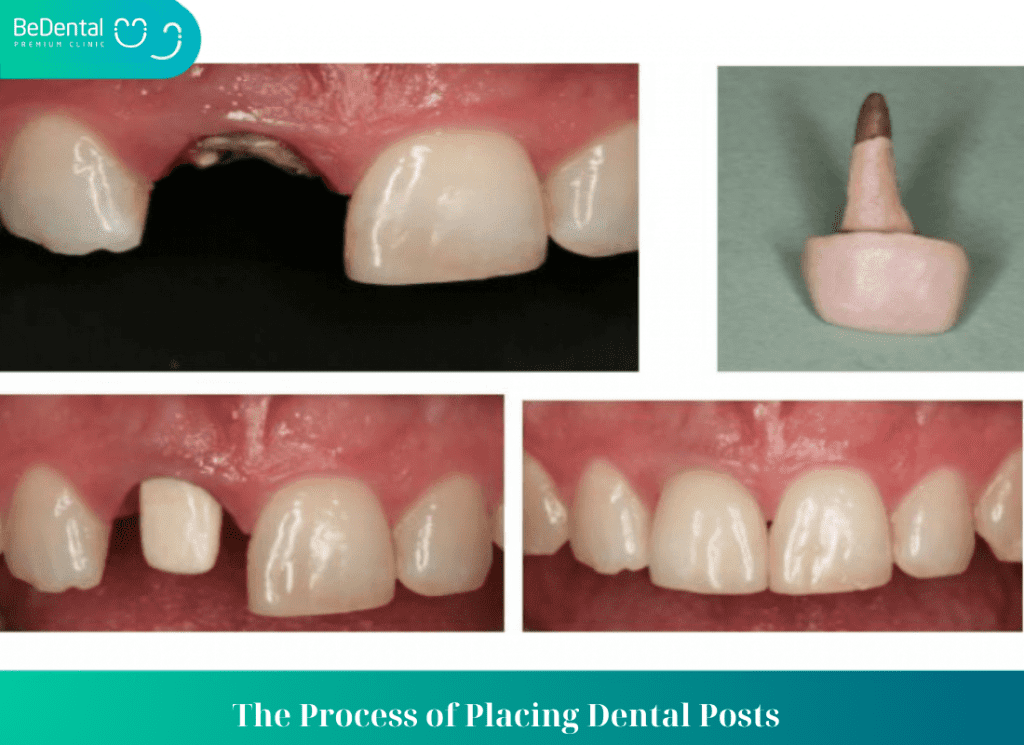Typically, dentists will try to save the tooth by performing root canal treatment, placing a post, and restoring the tooth structure before applying a ceramic layer to restore the tooth. So what is a dental post?
Directly placing a post and restoring the tooth is a restorative measure for cases of severely decayed teeth with minimal remaining tooth structure. This article will clarify what a dental post is.
What is a dental post? Why is a dental post needed?
First of all, we need to understand what a dental post is. In cases where the tooth is weakened after undergoing root canal treatment, a post is an important support method in the tooth restoration process, especially when the tooth structure is significantly broken, fractured, and there is minimal remaining tooth structure. Adding a post helps restore the structure of the tooth, creating better conditions for filling and ceramic tooth restoration. At the same time, a dental post also enhances the strength and longevity of the tooth.
Dental posts are usually small rods made of metal or glass fiber, directly placed into the root canal to increase the hardness and adhesion of the filling material. The choice of suitable post type will depend on the specific location of the tooth in the mouth.

Metal posts are typically made from metals such as gold or titanium, shaped like small screws and available in various sizes. They have high hardness and good load-bearing capacity. Usually, metal posts are applied to upper teeth, where high rigidity is needed but aesthetics are not crucial.
On the other hand, fiber posts are often made from materials like quartz, glass, or carbon fibers, transparent in color with high optical opacity. They are commonly used for back teeth, where aesthetics are important.
The process of placing dental posts is usually performed for cases where there is significant loss of tooth structure, fractures, or when a substantial portion of the tooth tissue is damaged, requiring post placement to reinforce and increase the tooth’s firmness.
The placement of a post in a tooth should only be done after completing root canal treatment and thorough tooth restoration. Because the post is directly attached to the root canal, tooth pulp removal needs to be carried out carefully and ensure complete cleanliness. After placing the post, removing it for additional root canal treatment can be challenging.
See more: Does getting braces hurt?
Such cases often lead to remaining tooth structure not being strong enough to support a ceramic crown to restore tooth function and aesthetics. Therefore, dentists typically place a post in the tooth after clearing the pulp, reconstructing the tooth core, and applying a ceramic crown to fully restore tooth function and appearance.
Do You Need Tooth Restoration with a Post?
Even if a tooth has lost a significant portion, with only half of the tooth remaining or even just the tooth root, it can still be preserved through post restorative methods. Many patients come with the intention of extracting decayed, cracked, or broken teeth, but dentists have helped preserve the natural tooth through endodontic treatment – post placement – ceramic crown restoration in just a few appointments.
Therefore, you have hope and the opportunity to preserve a seemingly damaged and non-functional tooth, as long as the tooth root is healthy and not severely infected. However, it is advisable to visit a reputable dental clinic as soon as possible to increase the chances of saving your tooth because delaying treatment may lead to eventual extraction.
The Process of Placing Dental Posts and Restoring Damaged Teeth After Post Placement:
- Widening the root canal: After completing root canal treatment, the dentist will use special instruments to widen the root canal, creating space to place the post.
- Choosing the appropriate post: Based on the position and size of the tooth needing restoration, the dentist will select the suitable type and quantity of posts according to the tooth’s condition.
- Securing the post with adhesive: The post will be securely attached to the tooth core using specialized dental adhesive.

- Tooth core restoration: After the post has been secured into the tooth core, the tooth will have a foundation. Dental filling material will be used to fill the missing space as in the regular filling process.
- Completion of tooth core restoration: The tooth will be carefully shaped to ensure proper occlusion, smooth surfaces, and no roughness. After placing the post, it is often necessary to cover the tooth with ceramic to ensure better chewing ability.
The Consequences of Improper Dental Post Placement.
What are the Consequences of Improper Dental Post Placement? The process of placing dental posts and restoring teeth brings many practical benefits to increasing the lifespan of teeth. However, if this process is not carried out fully and accurately, it may have the following consequences on dental health:
- Risk of tooth core fracture or tooth root crack: This often happens when the post is too large compared to the tooth root, leading to tooth cracks or fractures when prolonged chewing occurs. The intensity of the force applied can overload the tooth, potentially leading to irreparable tooth conditions and the need for extraction.
- Post dislodgement: Occurs when the post is placed too deep, too small, or too short, not providing enough retention for the filling material. In this case, both the post and the filling material may dislodge.
- Acute pulpitis, tooth abscess: If the pulp is not properly treated or if root canal treatment is not done correctly, bacteria can accumulate in the pulp canal after post placement, causing inflammation and pain for the patient.
See more: Extracting teeth before getting braces
The post placement procedure for teeth is typically done quickly and effectively in one appointment. However, to ensure your teeth are well-treated, it is important to visit reputable dental clinics with X-ray equipment to check the condition of the tooth pulp and core before proceeding with the procedure.
Possible Complications After Post Placement
Although dental post placement is an effective and safe method, if not followed correctly and done properly, it can lead to many complications. One common issue after placing a post in the tooth is tooth root cracking. This rate is so high that dentists are becoming increasingly hesitant to use metal posts and are transitioning to fiber posts.
However, fiber posts also have the risk of dislodgement. To address such unwanted consequences, it is important to seek out a reputable dental clinic where a dentist can advise and choose the best option for you. Do not worry if the dentist takes more time than usual to ensure that the post is placed deep into the pulp canal to meet the necessary technical specifications.

Does tooth post placement hurt?
Does tooth post placement hurt? During the process of tooth post placement, drilling the root canal to place the post vertically often involves some pain. If you are wondering if the tooth post placement process hurts, the answer is yes.
However, when a dentist performs the tooth post placement procedure, they typically apply local anesthesia to the gums to help reduce pain throughout the post placement process. Therefore, during the procedure, you often do not feel any pain. After the effects of the anesthesia wear off, you may feel some numbness or soreness, but this sensation usually does not last long.
Tooth post placement should be carried out by an experienced and highly skilled dentist to minimize pain. At the same time, the results after placing the post must ensure the following factors:
- The size of the post must be appropriate for the root canal.
- The filling layer must be done tightly.
- There should be no signs of infection in the root canal.
- The periodontal tissue must be in a healthy state.
Post-Restoration Dental Care
Post-restoration dental care is extremely important for protecting oral health and prolonging the lifespan of teeth.
To nurture effective oral care habits, you need to follow these steps:
- Brush your teeth at least twice a day with a soft-bristled toothbrush.
- Use dental floss to clean between your teeth and rinse your mouth with saltwater after brushing to prevent the growth of bacteria.
- Regularly check your oral health by visiting the dentist. This helps detect and address oral health issues in a timely manner.
If you experience issues after tooth restoration such as bleeding gums, swelling, or an unnatural bite, immediately visit the dentist for advice and treatment.
Conclusion
Based on the above guidelines, I hope it has helped clarify what tooth post placement is. Your teeth can be fully restored to their original state. Wishing you a smooth and successful tooth post placement treatment process!
See more: Why do children have bad breath
Tư vấn chuyên môn bài viết:
BÁC SĨ DƯƠNG THỊ THÙY NGA





